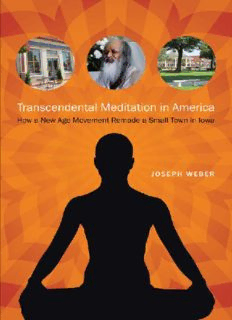
Transcendental meditation in America : how a new age movement remade a small town in Iowa PDF
Preview Transcendental meditation in America : how a new age movement remade a small town in Iowa
TranscendenTal MediTaTion in aMerica Recto Runningfoot ° 1 iowa and The MidwesT experience SERIES EDITOR William B. Friedricks, Iowa History Center at Simpson College The University of Iowa Press gratefully acknowledges Humanities Iowa for its generous support of the Iowa and the Midwest Experience series. 2 ° verso runningfoot Joseph weber Transcendental Meditation in america how a new age Movement remade a small Town in iowa UniversiTy of iowa press, iowa ciTy Recto Runningfoot ° 3 University of Iowa Press, Iowa City 52242 Copyright © 2014 by the University of Iowa Press www.uiowapress.org Printed in the United States of America Design by Teresa W. Wingfield No part of this book may be reproduced or used in any form or by any means without permission in writing from the publisher. All reasonable steps have been taken to contact copyright holders of material used in this book. The publisher would be pleased to make suitable arrangements with any whom it has not been possible to reach. Unless otherwise indicated, all photographs are the property of the author. The University of Iowa Press is a member of Green Press Initiative and is committed to preserving natural resources. Printed on acid-free paper isbn: 978-1-60938-235-3, 1-60938-235-8 (pbk) isbn: 978-1-60938-261-2, 1-60938-261-7 (ebk) lccn: 2013952706 4 ° verso runningfoot For Donna who keeps our feet on the ground Recto Runningfoot ° 5 6 ° verso runningfoot conTenTs Introduction: Who Cares about Fairfield, Anyway? 1 1. Classic Americana, with a Twist 8 2. Going for Baroque 16 3. Of God and Man 28 4. Unearthly Delights 50 5. Power of the Ballot 60 6. Higher Ed, Higher Realms 71 7. Death in Paradise 89 8. Enlightenment for All Ages 109 9. Just Business 125 10. The Disaffected 145 11. Maharishi Vedic City 167 12. Does TM Have a Tomorrow? 176 Acknowledgments 191 Notes 193 Recto Runningfoot ° 7 Selected Bibliography 205 Index 209 vi8ii °° vcoernstoe nrtusnningfoot introduction Who Cares about Fairfield, Anyway? remember what people used to say about meditation? now every- one is doing it. —shirley Maclaine a liTTle More Than fifty years ago, a bearded mystic, fond of flowers and flowing robes, arrived in the United States from India. The giggling guru, as Maharishi Mahesh Yogi came to be known, soon put a distinctive stamp on American culture. The country he found was a place of hard-charging ambition, churchgoing conformity, and extraordinary material success— the kind of success that emigrants from India had long admired. At first, many scorned the meditation he espoused as a technique for coping with stress and for plugging into spiritual realms beyond the workaday world. It seemed exotic, foreign, and ill-suited to American sensibilities. But the gen- tle, squeaky-voiced Easterner persisted, and soon rebellious Baby Boomers —looking for alternatives to the values and ways of life of their parents— took up his cause. Inspired by celebrity adherents as disparate as the Beatles, Clint Eastwood, Shirley MacLaine, and Merv Griffin, they lifted his message and his main product—meditation—into the mainstream.1 Since then, the change in attitudes toward meditation has been pro- found. Nowadays, doctors suggest meditation to patients struggling with ail- ments ranging from high blood pressure to anxiety. Gyms offer it along with weightlifting and aerobics. It’s even available in the air, via headset on Vir- gin Atlantic. And supporters urge it on students in violence-plagued urban who cares about fairfield, anyway? ° 1
Description: